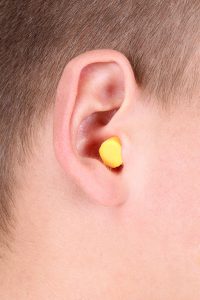Grounds for Change: Reducing Noise Exposure in the Grounds Management Professions – Part 2
Posted on byWorkers in grounds management professions, which includes landscaping, lawn maintenance and horticulturists, are often exposed to hazardous noise while on the job. Part One of this summer series discussed some of the dangers of noise, including hearing loss, tinnitus (ringing in the ears), and other health issues. In addition to its negative effects on personal health, loud noise can cause annoyance and stress. When working with noisy equipment, you should be able to recognize when noise levels are unsafe and what can be done to protect yourself and other workers.
Several strategies can be used to reduce noise exposure to safe levels. The “Hierarchy of Controls” is a system that helps by ranking noise reduction methods in order of effectiveness. The inverted pyramid is organized from most effective at the top (in blue), to least effective at the bottom (in red). Landscapers can use this system to evaluate their current noise reduction methods and determine if there is a better option.
 The most effective method of noise reduction is to eliminate the source of the noise, but this is not always possible. The work has to get done somehow! The next method of noise reduction is to implement a “Buy Quiet” program. This includes purchasing or renting quieter equipment to reduce worker noise exposure. This can be done when new businesses start up or when replacing older equipment. NIOSH and its industry partners are encouraging this approach in order to help protect those using loud tools as part of their jobs. Promoting the initiative also encourages manufacturers to design quieter equipment by creating a demand for quieter products. More about this program can be found in the Buy Quiet NIOSH science blog.
The most effective method of noise reduction is to eliminate the source of the noise, but this is not always possible. The work has to get done somehow! The next method of noise reduction is to implement a “Buy Quiet” program. This includes purchasing or renting quieter equipment to reduce worker noise exposure. This can be done when new businesses start up or when replacing older equipment. NIOSH and its industry partners are encouraging this approach in order to help protect those using loud tools as part of their jobs. Promoting the initiative also encourages manufacturers to design quieter equipment by creating a demand for quieter products. More about this program can be found in the Buy Quiet NIOSH science blog.
When eliminating noise or “Buying Quiet” is not an option, the next option is isolating workers from the noise source (for example, creating a physical barrier between the worker and the noisy equipment). Another noise reduction strategy is to limit the amount of time workers spend in loud noise (for example, by assigning workers noisy tasks for part of the day and quiet tasks for the rest of the day).

Last on the hierarchy is wearing Personal Protective Equipment, or PPE. PPE for noise reduction includes hearing protection devices (HPDs) such as earplugs or earmuffs. Whenever hazardous noise is present, workers should wear HPDs to reduce their noise exposure. Even though HPDs are low on the hierarchy, when used properly they can be very effective at reducing noise to safe levels. The reason they are low on the hierarchy is that oftentimes they are not worn, or they are worn incorrectly. Workers should be trained to use their HPDs properly and to check the fit. For a guide on how to properly wear earplugs click here. Workers also must be diligent about wearing their HPDs each and every time loud noise is present.
For grounds management professionals who use noisy tools, conditions like tinnitus and hearing loss can be a serious concern. Taking measures to protect employees from hazardous noise can help prevent these issues. The hierarchy of controls lays out the ways in which noise exposure can be reduced. Educating workers about the dangers of noise, proper use of HPDs, and purchasing quieter equipment are some of the ways to help prevent hearing issues in the long run. In the midst of the busy summer outdoor season, take a few minutes to make sure your HPD is worn correctly, visit NIOSH’S FAQ on occupational hearing loss and read more about the Buy Quiet Initiative to see if it is a possibility for your grounds management business in the future.
Jackie DiFrancesco BA, COHC, is a PhD candidate at the University of Connecticut and a summer fellow in the NIOSH Division of Applied Research and Technology.
Asha Brogan is an ORISE fellow in the NIOSH Division of Applied Research and Technology.
Bryan Beamer PhD, PE, CSP, is a research engineer in the NIOSH Division of Applied Research and Technology.
Posted on by

